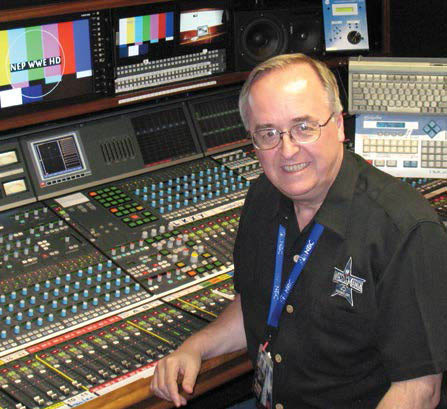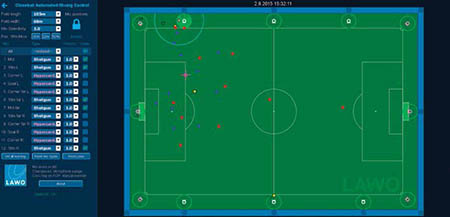Game Keeps Changing for Sports Audio
NEW YORK—The rules may not change—check that, the NFL is always tinkering—but broadcasters continue to look for ways to make sports programming more compelling for the home audience.
Randy Flick and Joe McSorley are seasoned A1’s who TV Technology has spoken with in the past; Andy Calvanese, vice president of technology and engineering at Wheatstone in New Bern, N.C., has a manufacturer’s eye view of trends in this area, as does Don Bird, vice president of business development for German-based Lawo. Some interesting developments have taken place recently according to these industry vets.

Randy FlickPROS AND CONS
“We’re experiencing a seachange in the way television is covering remote sporting events” said Calvanese. “We’re now able to take advantage of fiber and high-bandwidth Ethernet to send audio and video from the sports venue to the home production facility.”
McSorely says Ethernet and more compact trucks have changed things dramatically recently, but not necessarily for the better. “The trend is toward ‘streaming’ trucks,” he said. “They’re landscaping trailers, basically. There’s usually a massive air conditioner overhead. If a 60 cycle hum pops up, good luck hearing it—the environment has 85dB of noise to begin with! As audio was an afterthought in the 1980’s, so it has become again.”
Networks are now saving money by eliminating on site announcers. It’s not unusual for ESPN to station two or three announcers at their network and do play-by-play on multiple games during the day, reducing on site expenses dramatically.
SLIMMED DOWN NETWORKS
The professional video industry's #1 source for news, trends and product and tech information. Sign up below.

Lawo’s KICK technology automates audio mixing technology for live sports Nevertheless, vendors with an eye towards bringing the game closer to viewers via advanced audio technology are ramping up their development.
Lawo’s Bird says the company continues to innovate with their IP-based portfolio, citing the company’s extended surround formats 9.2-22.2 and Lawo’s new KICK technology for automated close-ball mixing. “Our Lawo Commentary System puts commentary off copper and onto IP—and has been used for all major global sporting events,” he said.
Bird noted that remote production now factors heavily as well. “Our customers can source audio at a venue that may be mixed, processed and assembled hundreds or even thousands of miles from the acquisition point,” he said. “With the combination of V__remote4 that connect to the stadiums, Lawo Nova73 audio routers and the use of Lawo’s VSM Broadcast Control and Monitoring System, broadcasters are producing high-quality content with the benefit of IP-based solutions.”
Flick says that the encroachment of Dante products into the flow has been huge in the last year or so. “WWE has a ton of Dante, one of the largest Dante mobile systems anywhere,” Flick said. “Steve Wahlenmeyer, one of our engineers, dedicates all of his time maintaining our Dante network. WWE uses nothing but fiber. Communications between our Calrec Hydra boxes, fiber boxes, and Dante devices, all of it is handled via Dante.”
Wheatstone’s Calvanese agrees that slimmed down networks have become the norm. “All that’s required to get audio and video back to the studio are interface boxes, some switches, media gateways if you need them for video, and a big, fat pipeline,” he said. For Wheatstone’s demonstration at NAB Show New York, the company set up an Artel IP-6000 [media gateway] in a cloud between two switches with its WheatNet-IP audio I/O units [BLADEs] on one end and mixing console and more WheatNet-IP audio BLADEs on the other, and had the whole thing up and running in an hour.
“The concept seems revolutionary, but the core notion is really quite simple: we are essentially extending the audio snake,” Calvanese said. “What we’re talking about here is IP audio networking, and with that, comes a few important benefits.”
“Immersive sound [3D audio] is a demand that is now reaching from the cinema world into the broadcast world,” Bird said. “We have been supporting development of tool kits for content creators and mixers that can be found in our mc² audio console series. On the flip side, doing a lot with virtual mixing technology, our VisTools, R3LAY and mxGUI systems put control onto touchscreen surfaces that can be highly customized for customer workflows and non-technical operators. Some of our latest boards aren’t even boards. They are mix engines that operate under control of other systems like Ross Overdrive and GV Ignite.”
FINALLY FIBER
Remote operation has also become widespread. “You are able to operate your remote gear directly from your console at the studio as if it were down the hall,” said Calvenese. “From your console in the studio, you’ll be able to control remote mic gain, EQ, and dynamics, plus mute or activate mics out in the field as needed, and save scenes and jump between different remote locations on the fly. You can feed audio to headsets or program anywhere at the remote venue.”
Flick relies on Calrec audio consoles. “They are so dependable; I’ve never had a single instance of failure in all the years I’ve been doing on air sports work,” he said.
“The design engineers at Calrec are constantly talking to mixers in the field,” Flick added. “Calrec incorporated an auto mix feature that is dynamite—you can group a group of microphones-announcer mics, say—and if you have three headsets, for example, and strap auto mixer across all three headsets, the console is smart enough to open up all them if all three are talking, or just one or two, if that’s what’s required, to reduce extraneous sound at a sports event where crowds or other background noise can be excessive.”
Today, virtually no XLR’s can be seen on many sets, and the confidence level in fiber has risen to the point where there are very few redundant systems in place. With home theater having reached maturation, the changes in delivery appear to center around cost saving methods and not a change in the product itself.
